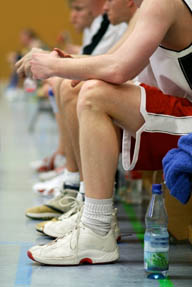Don't Drop the Ball, Buy the Right Shoe

Cross-trainers often seem like a good solution, but athletes shouldn't make them do everything. Playing a sport two to three times a week justifies buying sport-specific shoes.
"Generally, you want to go with a sport-specific shoe if you are participating in a sport on a regular basis," said Dr. Jim Christina, director of scientific affairs for the American Podiatric Medical Association.
What's the difference? APMA experts offer insight into choosing a sport-specific shoe that will provide the best performance for your needs:
Basketball: Whether executing the perfect pass or making that high-flying dunk, the features of basketball shoes will help you prevent injury.
* A thick, stiff sole gives support when landing jumps or running.
* The high-top construction provides the strongest support of the shoe. It reinforces the ankle during quick changes in direction.
* Basketball shoes should be replaced every two to three months for five-day weeks of play or when the soles become smooth.
Racquetball and Tennis: Court shoes for tennis and racquetball may look like ordinary athletic sneakers, but they're designed specifically for the body movements made during these sports.
* A court shoe supports both sides of the foot for quick stops and starts and weight shifts during side-to-side movement.
* The flexible sole enables quick shifts in direction.
* The court shoe absorbs less shock than a running or basketball shoe.
* Court shoes help prevent ankle injuries by providing less traction than running shoes.
Running: The running shoe is the most personal and intricate of all athletic shoes. Choices abound because every runner has specific needs.
* The running shoe provides maximum shock absorption to prevent ailments like shin splints and knee pain.
* It should control the way your heel strikes the ground so that the rest of your foot falls correctly.
* Know your foot type - high, medium or low arch - so you get the shoe with the best support.
* Shoes should be flexible in the area around the ball of the foot.
For more information on finding the right shoe, visit www.apma.org.

No comments: